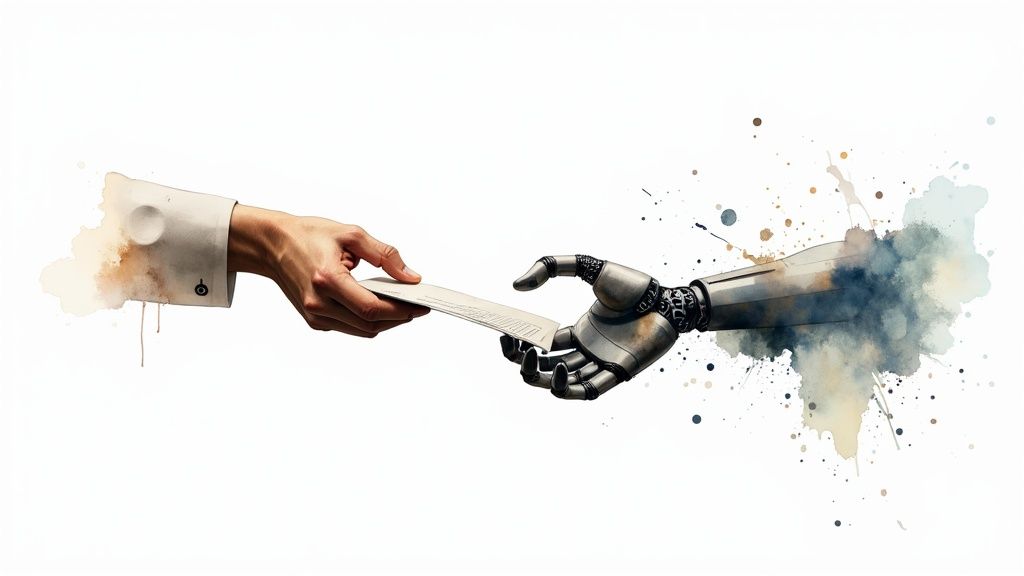How to Improve Workplace Efficiency That Lasts
Max
Improving workplace efficiency isn’t just about moving faster. It’s about working smarter. The real magic happens when you empower your teams, sharpen your processes, and bring in the right technology. That’s how you boost output without causing burnout.
What Real Efficiency Looks Like Today

True efficiency is so much more than just speed.
It’s a delicate balance between quality, sustainability, and—most importantly—the well-being of your team. Getting this right means:
- Giving teams the autonomy, clear goals, and learning opportunities they need to thrive.
- Cutting the fat from workflows by eliminating bottlenecks and clunky handoffs.
- Using smart tools to automate the repetitive stuff and free up people for high-impact work.
To make sense of it all, I find it helpful to break modern efficiency down into three core pillars. These are the areas where you’ll get the most bang for your buck.
Three Pillars of Workplace Efficiency
| Pillar | Key Focus | Primary Goal |
|---|---|---|
| People-First Culture | Giving teams clear goals, autonomy, and chances to grow their skills. | Building a confident, motivated, and highly capable workforce. |
| Smarter Processes | Identifying and removing bottlenecks, unnecessary steps, and messy handoffs. | Achieving smoother, faster throughput from start to finish. |
| Strategic Technology | Using automation and well-integrated tools to handle routine work. | Cutting down on manual effort and freeing up your team’s brainpower. |
Focusing on these three areas isn’t just a “nice-to-have”—it’s a massive competitive advantage.
It’s no surprise that 51% of executives are prioritizing employee upskilling, with wellness programs (45%) and workflow optimization (44%) close behind. This shift is fueling a productivity tools market now worth a staggering $59.88 billion. You can dig deeper into the numbers with these productivity statistics.
When you make progress visible and design work around your people, you create a system of productivity that lasts.
Whether your team is fully remote, in the office, or a mix of both, this framework turns everyday challenges into opportunities for growth.
Don’t Sacrifice Quality for Speed
Pushing for speed is tempting, but it can backfire if quality drops. Rushing often leads to mistakes that take even more time to fix later.
A simple peer review process can catch errors early before they snowball. Also, make sure everyone is crystal clear on what “good” looks like by setting clear quality benchmarks for every task.
Making Hybrid Teams Work
Hybrid work offers incredible flexibility, but it falls apart without clear ground rules. Chaos ensues when no one knows who is available or when.
Set core collaboration hours when everyone is expected to be online and available. For everything else, lean on asynchronous channels like Slack or Microsoft Teams to cut down on meeting fatigue and respect everyone’s focus time.
Make Improvement a Habit
Efficiency isn’t a one-and-done project; it’s a muscle you have to keep working.
Schedule regular retrospectives—even a quick 30-minute chat every other week—to talk about what’s working and what’s not. And don’t forget to track the small wins. Celebrating incremental progress is key to keeping the momentum going.
Why a Human-Centric Approach Wins
Always design your workflows around the people doing the work, not the other way around. When a process feels clunky or unnatural, it’s a sign that it needs to change.
Put team well-being front and center to prevent burnout. Invest in skill-building workshops that not only improve output but also boost confidence. Sometimes, simple changes like quick standing meetings or creating clear documentation can have the biggest impact.
How to Measure What Matters
You can’t improve what you don’t measure. The right metrics will guide your efforts and show you where you’re winning.
Start by tracking things like project cycle time, error rates, and team satisfaction scores. Get together with your team monthly to review the numbers and discuss what they mean. A transparent dashboard showing real-time data is a great way to keep everyone aligned and engaged.
Your First Steps
Ready to get started? Don’t try to overhaul everything at once.
Begin with a quick audit of your current workflows. Just ask your team to list their most common tasks and how much time they spend on them each week. From there, you can easily spot the top three friction points.
Aim to tackle just one small improvement each week. This approach creates a habit of continuous improvement, delivering steady gains that really add up over time.
Unlocking Potential Through People-First Leadership

You can have the slickest tools and the most refined processes, but they’ll fall flat without a motivated team to drive them. The human element is the real engine of efficiency, and good leadership is the key that turns it on. A manager’s job isn’t just to oversee tasks; it’s to architect an environment where people can truly do their best work.
This means looking past simple task management and digging into the things that really fuel productivity—psychological safety, clarity, and trust. When people feel safe enough to share ideas without a fear of failure, they innovate. When they know exactly what’s expected of them, they can execute with confidence.
Foster Psychological Safety and Trust
Psychological safety is the absolute bedrock of a high-performing team. It’s that shared belief that it’s okay to take interpersonal risks, like admitting you made a mistake or proposing a wild new idea. Without it, your team members will hold back, and you’ll lose out on valuable insights.
Here are a few ways leaders can build this sense of safety:
- Model vulnerability. When you’re open about your own missteps, it sends a clear signal to everyone else that it’s okay to be human.
- Encourage respectful debate. You want to create a space where different viewpoints are welcomed, not shut down. Frame disagreements as a collective search for the best solution, not a personal conflict.
- Respond productively to failure. Treat mistakes as learning opportunities. Instead of pointing fingers, ask, “What can we learn from this to make our process better?”
A culture where people feel heard and respected is non-negotiable for improving workplace efficiency. It directly impacts collaboration, problem-solving, and ultimately, your bottom line.
This foundation of trust is also a game-changer for keeping your best people around. To dive deeper, check out our guide on how to improve employee retention.
Provide Crystal Clear Goals and Expectations
Ambiguity is a productivity killer. When teams aren’t sure about their priorities or what “done” actually looks like, they waste time and energy spinning their wheels on the wrong things. Great leaders cut through that confusion by setting clear, measurable goals.
Don’t just say, “improve customer engagement.” Give them a specific target: “Let’s increase our customer response rate on social media by 15% this quarter by implementing the new triage system.” That kind of clarity empowers your team to focus their efforts and see their progress in real-time.
This is even more critical when you look at the current state of the workforce. Disengagement is a massive drain on efficiency, with engagement rates falling to just 21%. Even managers are feeling it, with their engagement dropping from 30% to 27%. Since managers influence about 70% of team engagement, their motivation has a huge ripple effect. You can find more insights on these workplace trends on Gable.to.
Invest in Continuous Skill Development
Investing in your team’s growth isn’t just a perk; it’s a direct investment in your company’s capability. When you give people opportunities for upskilling and reskilling, you build a workforce that is more agile, competent, and motivated.
This doesn’t have to mean sending everyone to expensive, off-site training courses. It can be as simple as:
- Setting up peer-to-peer mentoring programs.
- Getting subscriptions to online learning platforms.
- Carving out dedicated time each month for self-directed learning.
By empowering your team with new skills, you’re equipping them to solve bigger problems and tackle new challenges with confidence. That makes for a much more efficient and resilient unit.
Streamlining Workflows to Eliminate Hidden Friction

Even the most talented teams get bogged down by clunky processes. The real productivity killers are often the small, frustrating bottlenecks hiding in your daily workflows—those silent drains on energy, time, and morale. Tackling these head-on is one of the most practical ways to boost your team’s efficiency.
What are the usual suspects? Think confusing communication chains, repetitive manual tasks that make your eyes glaze over, and messy handoffs between colleagues. These little hiccups add up, leading to blown deadlines and a whole lot of unnecessary stress. In fact, research shows that messy collaboration can cost employees three hours of productivity every single week.
Map Your Process to Find the Bottlenecks
You can’t fix what you can’t see. The first step is to get your entire workflow down on paper (or a whiteboard). This doesn’t have to be some overly complicated, formal exercise. A simple flowchart will do wonders.
Get the team together and walk through a common task from beginning to end. Let’s say you’re a marketing team creating a new blog post. You’d map out everything from the initial idea and writing process to the review cycle, design phase, and final publication. At each step, start asking some tough questions:
- Where do things consistently get stuck or delayed?
- Which steps require input from too many people, creating confusion?
- What tasks are we doing over and over that a tool could handle for us?
This exercise is always an eye-opener. You might realize the “review” stage is a total black hole because no one has clear ownership, or that your designers are constantly twiddling their thumbs waiting for final copy. Finding these specific friction points is half the battle.
Implement Simple Fixes for Big Gains
Once you’ve spotted the problems, you can start rolling out simple, high-impact solutions. In that marketing team example, a chaotic handoff between writers and designers was causing constant delays. Their fix? A shared Kanban board using a tool like Trello or Asana.
With a Kanban system, everyone can instantly see the status of each task. A card moves from “Writing” to “Ready for Design” only when all necessary assets are attached, completely eliminating the back-and-forth emails and missed information.
Standardized checklists are another game-changer. They reduce the mental load and prevent silly mistakes on routine jobs. Whether it’s onboarding a new client or publishing the weekly newsletter, a simple checklist ensures no critical step gets forgotten.
Finally, so much friction comes from murky communication. Our guide on ways to improve workplace communication has tons of practical tips for bringing more clarity to your team. To go a step further, look into integrating speech-to-text into daily workflows to increase productivity; it’s a great way to minimize manual typing and speed up documentation.
Remember, streamlining your workflow isn’t a one-and-done project. It’s about building a continuous habit of finding and fixing whatever slows you down.
Using Technology and AI to Work Smarter

The right technology can feel like a superpower, automating the mundane stuff and freeing up your team for the work that truly matters. The wrong tech, though? It’s just another distraction. Building an intelligent tech stack is all about being strategic, not just jumping on the latest trend.
The goal here is a seamless ecosystem where tools actually talk to each other. When your project management software syncs with your communication platform, you create a single source of truth. No more digging through ancient email chains or chat logs for the latest update. It’s all connected, which nips confusion and wasted time in the bud.
Automate Repetitive Tasks
Automation is your best friend when you’re trying to boost efficiency. It’s built for those low-value, repetitive tasks that drain your team’s energy and pull their focus away from bigger goals. Just think about all the routine jobs that pop up every day or week.
- Automated Reporting: Instead of manually pulling data for weekly reports, use tools to generate and send them out automatically.
- Email Sequences: For sales or marketing, automated follow-up emails keep the conversation going without any manual effort.
- Data Entry: Connect your apps to move information between systems on their own, which also cuts down on human error.
By taking these chores off your team’s plate, you hand them back precious hours they can use for strategic thinking and creative problem-solving. This isn’t just about saving time; it’s about keeping employees engaged and preventing burnout. Effective task automation is a core part of a much bigger strategy, and you can learn more about managing your workload in our guide on how to improve time management skills.
Harness AI as a Smart Assistant
Artificial intelligence isn’t some far-off concept anymore—it’s a practical tool that can seriously amplify your team’s abilities. Think of AI as a powerful assistant that excels at processing information and churning out first drafts, not as a replacement for human talent.
For instance, a sales team could use an AI-powered CRM that suggests the best times to contact leads or even drafts personalized follow-up messages. This lets salespeople get back to what they do best: building real relationships with clients.
AI should be viewed as a collaborator that handles the heavy lifting of data analysis and content generation, allowing your team to focus on strategy, creativity, and connection.
This is more relevant than ever, with 58% of workers now using AI in their daily workflows—double what it was in 2022. But the real trick is managing all these digital tools without losing focus. That’s a huge challenge when employees face distractions roughly every three minutes and need an average of 23 minutes to get back on track after each one. Discover more insights about these workplace statistics on eptura.com.
Choose and Implement Tools Wisely
Just throwing new software at your team won’t solve efficiency problems. In fact, it might create new ones. The key is to pick tools with a clear purpose and then actually train people on how to use them.
Before you bring in a new tool, ask yourself a few critical questions:
- What specific problem does this solve? Make sure it tackles a real bottleneck in your workflow.
- Does it integrate with our existing tools? You want to break down information silos, not build new ones.
- Is it user-friendly? A tool with a steep learning curve is a tool nobody will use.
Once you’ve made your choice, a structured rollout is non-negotiable. Host training sessions, create simple how-to guides, and maybe even pick a “champion” on the team who can help their colleagues out. This approach ensures the technology becomes a genuine asset that actually helps your team get things done.
Boosting Efficiency in Remote and Hybrid Teams
Working from anywhere throws a new set of challenges our way, but it also unlocks some incredible chances to get way more efficient. When your team isn’t sharing an office space, the old productivity playbook goes right out the window. Your success really boils down to being intentional about building a great culture and setting crystal-clear communication norms that are actually designed for a distributed world.
The biggest mental shift is moving away from a constant reliance on synchronous, real-time collaboration. The highest-performing remote and hybrid teams I’ve seen have mastered asynchronous communication. This approach is a game-changer because it respects everyone’s focus time, fights back against the never-ending meeting fatigue, and gives people the power to structure their days for deep, uninterrupted work.
Embrace Asynchronous Communication First
Asynchronous work isn’t about ignoring your colleagues. Not at all. It’s about communicating with so much clarity that an immediate response just isn’t necessary. This means consciously replacing those “quick” video calls with detailed project briefs, thoughtful updates, and well-considered comments on shared documents.
This shift empowers team members to finally disconnect from the constant digital chatter and just get stuff done. It’s a pretty fundamental change, and it definitely requires a fresh approach to management. If you want to go deeper on this, we’ve put together a full guide on how to manage remote teams.
Of course, making this work requires having the right tools and, just as importantly, clear guidelines on how to use them.
Choosing the Right Communication Tool for Hybrid Teams
Figuring out which tool to use for what can feel overwhelming, but it’s crucial for cutting down on noise and ensuring messages are seen by the right people at the right time. Here’s a quick breakdown I use to guide teams on when to use what.
| Communication Tool | Best For | Potential Pitfall |
|---|---|---|
| Formal announcements, external communication with clients, and sending official documents. | Can get buried quickly and is incredibly slow for any real-time collaboration or quick feedback loops. | |
| Instant Messaging (Slack, Teams) | Quick questions, urgent updates, and informal team bonding or water-cooler chat. | Easily creates a culture of “always on” urgency and is a major source of constant interruptions. |
| Project Management Tools (Asana, Trello) | Documenting tasks, sharing progress updates, and centralizing feedback on specific deliverables. | Only works if the entire team commits to using it consistently. Otherwise, it just becomes another forgotten tool. |
By defaulting to asynchronous methods whenever possible, you suddenly make your synchronous meetings—like actual video calls—way more valuable and purposeful. They become a strategic tool, not a default reaction.
Make In-Office Time Intentional
For hybrid teams, the office should never be a place where people commute just to sit quietly with headphones on. That completely defeats the purpose and, frankly, wastes everyone’s time. Instead, you need to transform your in-office days into intentional hubs for high-value collaboration that’s just plain harder to do remotely.
Try structuring these days around specific, high-impact activities:
- Strategic Brainstorming Sessions: Get out the whiteboards and sticky notes. Use the physical space to map out complex ideas and workflows together.
- Team-Building Activities: Focus on strengthening the personal connections that fuel trust. Better trust leads directly to better remote collaboration.
- Complex Project Kickoffs: Get everyone aligned in the same room to hash out all the details, clarify roles, and build momentum from day one.
By making office time purposeful, you maximize its value and make sure the commute actually feels worth it. This single strategy can do wonders for maintaining a vibrant company culture and reinforcing the bonds that make remote work truly successful.
Navigating the unique challenges of a distributed team isn’t always easy. For companies looking for more frameworks and guidance, a comprehensive remote work toolkit can offer some invaluable resources.
Ultimately, boosting efficiency in a remote or hybrid model is all about building a system founded on trust, clarity, and intentionality. It’s that system that empowers your team to do their best work, no matter where they happen to be logging in from.
Common Questions About Workplace Efficiency
Even with a solid plan, you’re bound to run into questions when you start tweaking your team’s efficiency. Let’s tackle some of the most common ones I hear from leaders, with straight-to-the-point advice you can use right away.
What Is the Biggest Roadblock to Efficiency?
It’s probably not what you think. The single biggest obstacle isn’t a clunky process or outdated software—it’s ambiguity.
When your team is even slightly unsure about their priorities, what a “win” looks like, or who has the final say, they spin their wheels. This uncertainty leads to hours wasted in pointless meetings and endless rework. Clarity is the ultimate efficiency hack. As a leader, it’s on you to set crystal-clear goals, define everyone’s roles, and make sure each person knows exactly how their work pushes the company forward.
How Do I Measure If My Efforts Are Working?
You can’t improve what you don’t measure, but you don’t need some complex, color-coded dashboard to get started. Just begin by tracking a few simple metrics that give you a real pulse on your team’s workflow.
- Task Completion Rates: Are things getting done on time? This is a great, simple way to spot bottlenecks before they become major problems.
- Quality Benchmarks: Is the work consistently good? Keep an eye on error rates or how often things need to be revised.
- Team Engagement: You can gauge this with quick pulse surveys. Happy, engaged people are almost always more productive.
Talk about these numbers with your team regularly. The point isn’t to micromanage—it’s to have open, honest conversations about what’s working and what needs a little nudge. This approach makes improving efficiency a team sport.
What Is the Leader’s Most Important Role?
Your main job in boosting efficiency is to be an architect of the work environment. It’s not about cracking a whip to make people work faster; it’s about systematically removing the obstacles that are slowing them down.
Leadership is the key to unlocking a team’s full capacity. Through strategic direction, open communication, and a focus on accountability, leaders empower their teams to reach new heights of success.
This means creating a culture of psychological safety where people feel comfortable speaking up. It means giving them the right tools and resources. And it means modeling the kind of high-trust, accountable behavior you expect from everyone else. Your job is to create the conditions for your team to do their best work.
Where Should I Start First?
Don’t try to boil the ocean. You’ll just get overwhelmed. The smartest first step is to pick one, high-impact area and focus all your energy there.
A great way to find this is to run a simple “friction audit.” Just ask your team: “What is the single most frustrating, time-sucking part of your week?”
I guarantee their answers will point you directly to the biggest pain point. It could be a buggy piece of software or a confusing approval process. Whatever it is, fixing that one thing will deliver an immediate, visible win. This builds momentum and gets your team on board for future improvements. The challenges of remote work, for example, often reveal communication friction, an issue you can learn more about in our guide to common remote work challenges. By tackling these small but meaningful problems, you build a lasting culture of continuous improvement.
Ready to build a high-performing remote team or find your next great opportunity? Remote First Jobs connects top talent with leading remote-first companies. Explore thousands of verified listings and find your perfect fit today at https://remotefirstjobs.com.


